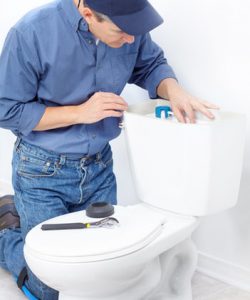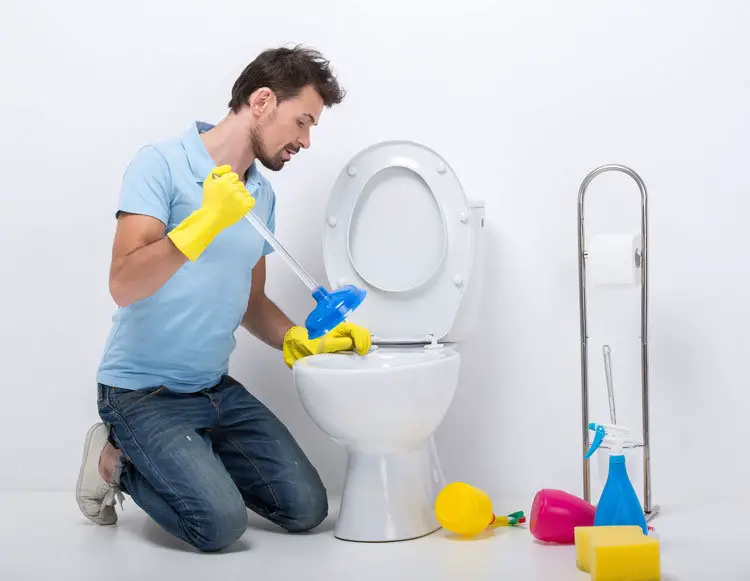Toilet Water Rises Too High When Flushed? (Here’s What To Do)

Having a working toilet is a necessary part of every day modern life. When something arises with your toilet, it can be extremely frustrating and a cause for concern. Rather than run to a nearby gym or neighbours house to use their toilet, you can attempt to fix it yourself.
There are many problems that occur with toilets, but one, in particular, is that the water can rise too high when you flush it. Your toilet water level is regulated by the level of water that is in the tank, as well as the internal S-trap. There is also a section inside of the toilet bowl that is emptied when the flush breaks. When this occurs, the bowl level rises too high, over the height of the trap outlet.
Sometimes, the best way to fix the problem of water rising too high when flushing is actually to add more water to the tank. Other times, you may need to check for blockages. In general, first, you need to identify what is going on with your toilet to understand the true reason for the water rising roo high.
Before you begin attempting to fix your toilet issues, you need to take a few steps:
Note: Always clean and disinfect the bowl before reaching in to remove the blockages.
 Start by clearing all blockages in the waste line. Use a plunger if possible. This should be done if the bowl seems like it is going to overflow. If the plunger does not work, then you can use your toilet auger (also known as a plumbing snake).
Start by clearing all blockages in the waste line. Use a plunger if possible. This should be done if the bowl seems like it is going to overflow. If the plunger does not work, then you can use your toilet auger (also known as a plumbing snake).
To use your toilet auger, press it into the bowl until you feel a bit of push back. Turn the snake handle. The auger should work its way through the blockage and the toilet level will drop.
If there is still an issue with a blockage, you can then climb on the roof and clear debris from the vent opening. This is due to the fact that debris in the vent line will block air to your toilet, and promote slow draining. It also aids in the formation of blockages.
If you believe there may still be a blockage it may be down the vent pipe. You can spray water from your hose into the vent opening. This should clear it.
At this point, you need to turn off the water to the toilet. Hold the flushing handle down, this should clear the tank.
Put on your rubber gloves, reach into the bowl, and take out any toilet paper, tampons, or other debris. This is very important as these can create a blockage that pushes the water out of the bowl.
Turn the water back on. If there is no more debris in the bowl you can allow the tank to fill. After it fills, check the water level. It should not be more than 1 inch below the opening of the overflow tube. If it is not as high as that, then there is not enough water entering the bowl after a flush to fill it.
Now it is time to adjust the fill level. Do this by resetting the float. To reset the float you can screw it clockwise to shorten the length of the rocker arm it is attached to. By doing this you can put less pressure on the valve that fills the toilet, and it will take longer to close.
Now you should find the collar-style float that fits around the fill tube. Find the adjustment screw on top of the float rod, and turn it counterclockwise with your screwdriver. This will do the opposite of what you have done before, and lengthen the rod to keep the valve open.
You may find a clip instead of a screw. In these types of toilets, you can squeeze the clop and push the rod down.
If you still need to adjust the water level you can turn the adjustment screw on top of the fill valve. Loosening the screw can be done by turning it counterclockwise. This will require the float to rise higher to close the valve.

If you have a dog that drinks from your toilet, it may be the reason that the water level is low in your bowl. To avoid this, always close the lid, and provide your pet with enough freshwater elsewhere. the cause of a bowl level that is too low. Provide your pet with another source of water.
If you do not often use your toilet and you leave the lid open, you may have low water levels because it is evaporating. The simple fix to this is to close the lid when you aren’t using the toilet.
If your toilet won’t stop running or seems noisy when you are not using it, then you may need to replace the toilet fill valve. Your running toilet may also be due to the tank water level being too high, which you should have fixed above.
Find the float arm. Bend this downward. It should eventually reach a level that turns off the water. You might need to move it around a bit to find the “sweet spot”. Turn on the water and flush the toilet to test the flapper.
If you have a faulty toilet flapper or flush valve, you may also have a “phantom flush”. This occurs when your toilet seems to be flushing without anyone pressing the handle. In this case, you most likely need to replace either the flapper or the entire flush valve.
Make sure the water supply valve is fully turned to the open position. You can also check the water supply line for leaks.